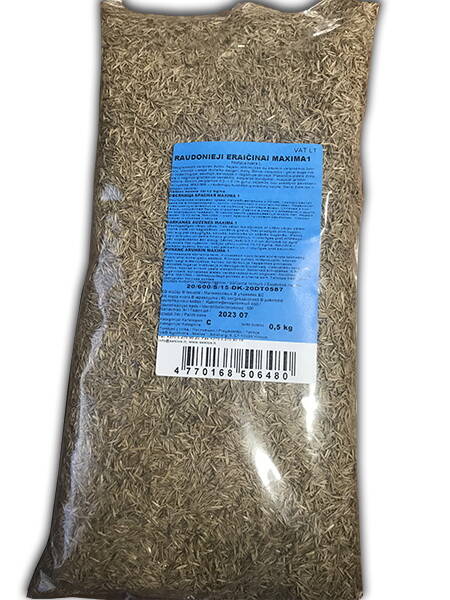Your shopping cart is empty!
Strong creeping red fescue "Maxima 1"
Strong creeping red fescue "Maxima 1".
You can rely on "Maxima 1" all year round: beautiful appearance, stress resistance, disease resistance and unprecedented frost resistance!
Perennial low-growing grass. Quickly forms a decorative, dense and fleecy grass stand. Requires minimal maintenance and is considered a “lazy man's lawn.”
Color saturation: medium green. Slowly grows back after mowing.
Used to create a high-quality lawn in the shortest possible time (can be used as a one-component drought-resistant lawn with high decorative qualities for ground areas or for repairing existing grass cover).
Agricultural technology.
The soil is dug up to a depth of 20-25 cm, debris and weeds are removed and the top layer is loosened to a depth of 2.5-5 cm. If the area is subject to stagnation of moisture, then drainage is necessary.
5-7 days before sowing, it is advisable to apply complex mineral fertilizer at the rate of 60.0 g/m2.
Sowing: from April to September in moist soil in two directions: 1⁄2 of the seeds along the length and 1⁄2 along the width of the plot.
Sowing depth: 0.5-1.0 cm.
At the end of sowing, the seeds are carefully embedded in the soil and rolled. Shoots appear 21-23 days after sowing, with mandatory watering.
The first mowing of the lawn is carried out when the grass has grown by 5-8 cm, cutting off 1-2 cm. Subsequent mowings are carried out at 1⁄3 of the height of the plant, periodically changing the direction of mowing.
When sowing in autumn, no cutting is carried out. For favorable development of red fescue in the first year, it is recommended to sow it together with annual ryegrass, which forms a protective grass stand that reduces weed infestation.
You can rely on "Maxima 1" all year round: beautiful appearance, stress resistance, disease resistance and unprecedented frost resistance!
Perennial low-growing grass. Quickly forms a decorative, dense and fleecy grass stand. Requires minimal maintenance and is considered a “lazy man's lawn.”
Color saturation: medium green. Slowly grows back after mowing.
Used to create a high-quality lawn in the shortest possible time (can be used as a one-component drought-resistant lawn with high decorative qualities for ground areas or for repairing existing grass cover).
Agricultural technology.
The soil is dug up to a depth of 20-25 cm, debris and weeds are removed and the top layer is loosened to a depth of 2.5-5 cm. If the area is subject to stagnation of moisture, then drainage is necessary.
5-7 days before sowing, it is advisable to apply complex mineral fertilizer at the rate of 60.0 g/m2.
Sowing: from April to September in moist soil in two directions: 1⁄2 of the seeds along the length and 1⁄2 along the width of the plot.
Sowing depth: 0.5-1.0 cm.
At the end of sowing, the seeds are carefully embedded in the soil and rolled. Shoots appear 21-23 days after sowing, with mandatory watering.
The first mowing of the lawn is carried out when the grass has grown by 5-8 cm, cutting off 1-2 cm. Subsequent mowings are carried out at 1⁄3 of the height of the plant, periodically changing the direction of mowing.
When sowing in autumn, no cutting is carried out. For favorable development of red fescue in the first year, it is recommended to sow it together with annual ryegrass, which forms a protective grass stand that reduces weed infestation.
Mark of lot Nr.: 22/600/Š/14-DK-22NA2171.
Category: C.
Strong creeping red fescue. Bot.: Festuca rubra L. ssp. rubra.











